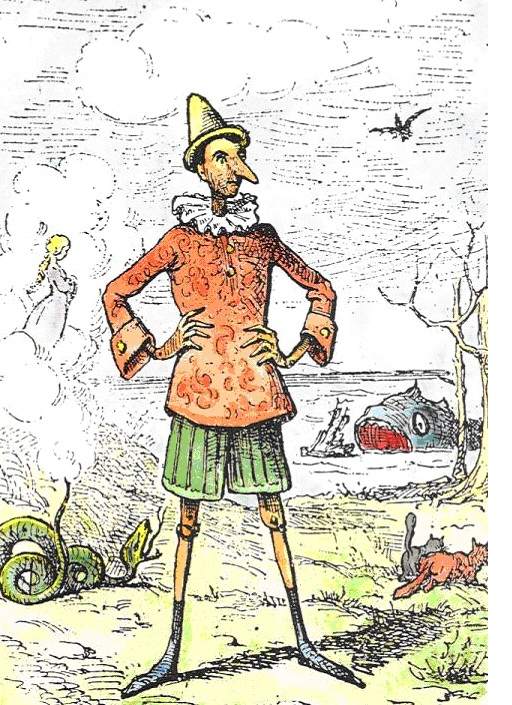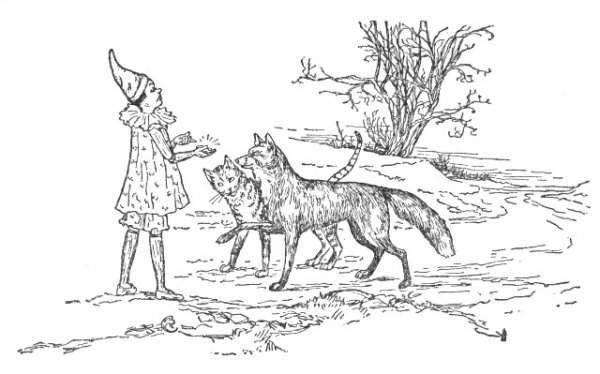Throughout the long history of fiction, androids and gynoids – artificial men and women – have been a common element. When included as tertiary characters they are often symbols for “the other.”
When treated as protagonists, they fill the tale with themes of the roles and definitions of humanity. Thus, this series is taking a close look at these artificial people. Today we’re looking at Pinocchio.

Pinocchio is the protagonist of the 19th century novel The Adventures of Pinocchio by Carlo Collodi.
The book was originally a much shorter story, in Italian, which had been serialized. That original story was not specifically for children, as it was intended more as a political statement.
This is interesting because by the time it was translated into English, the story had undergone some changes (most notably the original ending became a mid-point depression instead, leading into a longer tale. This is mostly because of the influences of Victorian England, which was spreading quickly.
The invasive idea was that children are special, and need special things just for them. Children’s books, children’s meals, children’s games, children’s fashion; there had been no concept of these things before the 19th century, and in the mid 1880’s the ideas spread to Italy, where Collodi’s publisher refused to publish a story about a child, which ended in the child’s death, even if the child was just a puppet.
Without that influence, we would think of Pinocchio much differently today. Of course anything Disney chooses to adapt becomes heavily twisted in American minds anyway.
In the original story, Pinocchio is not a puppet who has been granted sentience. Instead he is a magic block of wood. He was already able to talk – rudely – long before he was carved. It was, in fact, this property which made Geppetto decide that this was the perfect block from which to carve his marionette. Geppetto was not a puppet carver by trade, but rather, he wanted to use Pinocchio to make money by performing on the street.
After he was carved, however, he looked and acted so much like a real boy that Geppetto couldn’t handle him. One of the first things he did was run to the police and tell them Geppetto was being mean to him, so they would lock him in jail. Pinocchio then promptly returned to Geppetto’s home, where he murdered the sentient, talking cricket who had been living in the walls for a century, when the cricket warned him against disobeying adults – boys who don’t listen grow up to be asses.
Later, after Geppetto returns from jail, he decides to send Pinocchio to school to help him become a ‘real boy’. Pinocchio dumps the school idea, however, when, along the way he sees a marionette theater, and sells his books to buy a ticket for the show. There he finds that he is not the only sentient marionette in the world, as two others are performing on stage, apparently carved from talking wood, the same way he was. He nearly gets one of them killed however when he goes back-stage to visit them, and the puppet master pays him back more than the ticket cost just to go away.

He never again returns to Geppetto’s house, however, as on his way home, he is accosted by a talking fox and cat who are respectively pretending to be lame and blind. The two try to swindle him out of his coins, but when they see that the con is taking too long to pay off, they simply attack him, and try to take his coins.
He hides the coins in his mouth, so the fox and cat hang him by his neck in a tree, hoping to get the coins when he dies. He takes so long to die, however that the animals eventually get impatient and leave. That’s where the story ends as originally told, with the poor puppet boy dying in a tree, with no one to rescue him.
The story is, of course a cautionary tale against the cons of strangers and distraction from noble pursuits, but it also carries heavy symbolism. The idea of becoming a ‘real boy’ is symbolic of achieving a middle class lifestyle, while becoming an ass is a clear symbol of the time (more of a figure of speech in Italy) for the lower class life.
So, he could either go to school, get educated and be “real” or he could become a puppet (and eventual victim) of the government and the aristocracy (the fox and the cat). If he chose to do neither, he would instead become an ass. So, the story becomes an allegory which pushes the virtue of education and the importance of the independence of the middle class from the upper class.
Of course, the tacked on “second half” of the Adventures changes the tone of the lesson significantly, if not the message itself. If the English translation had ended there, our idea of a “Pinocchio figure” in literature would be much different today.
The symbolism remains the same, in the new portions of the story, but the challenge increases. It’s not just about going to school anymore. Pinocchio must face a whole host of challenges and temptations to get there. Following the boredom induces departure of the fox and cat, Pinocchio is rescued from the tree by the blue fairy, who tells Pinocchio to go and get Geppetto to come and live with them in the forest. On his way back, he gets distracted by the fox and cat again, falling for the same con they tried on him earlier. This time they wait patiently for it to pay off, and Pinocchio is left penniless and lost.
Afterward he moves through several challenges which test his wit and morality, sometimes guided by the talking cricket who, it turns out, is not dead after all. The most famous of these id the trip to “play land,” where lazy boys turn into donkeys because they play all day and do no real work. He succumbs to the temptation, and goes to play-land, only surviving the place because it turns out that wooden boys are immune to being changed permanently into asses.
When he finally managed to make it to school, he becomes a more moral person, and loses his streak of impetuousness and immaturity in a single good day of lessons. On his way to his second day of school, he display his maturity by giving all of his coins (which were supped to go toward a new suit) to the blue fairy, who claims to be dying. That night, she visits him at home in his bed and kisses him, turning him into a ‘real boy’ at last.
It’s this second part which forms our strongest impression of what the Pinocchio story is about. Symbolism aside, it’s about striving for the things you want and need in life, and not allowing distractions to take you off course. There is also a theme of redemption here as no matter how many times Pinocchio is taken off that course, he is always let to find his way back to it. No matter how far he sank, there was always a path back up to the surface, and that path was education.
Check back tomorrow, when our featured artificial person will be Prometheus. If you have an idea for an android or gynoid we could feature, let us know in the comments.






